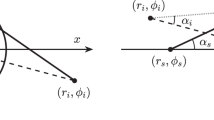Abstract
We investigate the propagation of light signals across multiple gravitational lenses, with particular emphasis on the “communication bridge” scenario of two lenses with collinear source and observer. The lenses are assumed to be non-coplanar, far enough from one another for each lens to be treated independently as thin lenses in the limit of weak gravity. We analyze these scenarios using several different tools, including geometric optics, photon mapping, wave optics and ray tracing. Specifically, we use these tools to assess light amplification and image formation by a two-lens system. We then extend the ray tracing analysis to the case of multiple non-coplanar lenses, demonstrating the complexity of images that are projected even by relatively simple lens configurations. We introduce a simple simulation tool that can be used to analyze lensing by non-coplanar gravitational monopoles in the weak gravity limit, treating them as thin lenses.











Similar content being viewed by others
References
Eshleman, V.R.: Gravitational lens of the sun: its potential for observations and communications over interstellar distances. Science 205(4411), 1133–1135 (1979). https://doi.org/10.1126/science.205.4411.1133
Maccone, C.: Interstellar radio links enhanced by exploiting the Sun as a gravitational lens. Acta Astronaut. 68, 76–84 (2011)
Schneider, P.S., Ehlers, J., Falco, E.E.: Gravitational Lenses. Springer, Berlin (1992)
Toth, V.T.: Imaging with a gravitational lens: the geometric view. Mon. Not. R. Astron. Soc. 527(1), 1141–1145 (2024). https://doi.org/10.1093/mnras/stad3293. arXiv:2308.16452 [astro-ph.IM]
Turyshev, S.G.: Gravitational lensing for interstellar power transmission. ArXiv (2023). arXiv:2310.17578 [gr-qc]
Turyshev, S.G., Toth, V.T.: Diffraction of electromagnetic waves in the gravitational field of the Sun. Phys. Rev. D 96, 024008 (2017). https://doi.org/10.1103/PhysRevD.96.024008. arXiv:1704.06824 [gr-qc]
Turyshev, S.G., Toth, V.T.: Imaging extended sources with the solar gravitational lens. Phys. Rev. D 100, 084018 (2019). https://doi.org/10.1103/PhysRevD.100.084018. arXiv:1908.01948 [gr-qc]
Turyshev, S.G., Toth, V.T.: Photometric imaging with the solar gravitational lens. Phys. Rev. D 101, 044025 (2020a). https://doi.org/10.1103/PhysRevD.101.044025. arXiv:1909.03116 [astro-ph.IM]
Turyshev, S.G., Toth, V.T.: Image formation process with the solar gravitational lens. Phys. Rev. D 101, 044048 (2020b). https://doi.org/10.1103/PhysRevD.101.044048. arXiv:1911.03260 [gr-qc]
Turyshev, S.G., Toth, V.T.: Image formation for extended sources with the solar gravitational lens. Phys. Rev. D 102, 024038 (2020c). https://doi.org/10.1103/PhysRevD.102.024038. arXiv:2002.06492 [astro-ph.IM]
Turyshev, S.G., Toth, V.T.: Diffraction of electromagnetic waves by an extended gravitational lens. Phys. Rev. D 103, 064076 (2021). https://doi.org/10.1103/PhysRevD.103.064076. arXiv:2102.03891 [gr-qc]
Turyshev, S.G., Toth, V.T.: Recovering the mass distribution of an extended gravitational lens. Mon. Not. R. Astron. Soc. 513(4), 5355–5376 (2022). https://doi.org/10.1093/mnras/stac1174. arXiv:2108.07172 [gr-qc]
Acknowledgements
VTT thanks Slava Turyshev for discussions and acknowledges the generous support of David H. Silver, Plamen Vasilev and other Patreon patrons.
Author information
Authors and Affiliations
Contributions
VTT is the sole author of this manuscript, and also prepared all figures and the referenced software.
Corresponding author
Ethics declarations
Competing interests
The authors declare no competing interests.
Additional information
Publisher’s Note
Springer Nature remains neutral with regard to jurisdictional claims in published maps and institutional affiliations.
Appendix A: Ray tracing software implementation
Appendix A: Ray tracing software implementation
Images presented in this paper were created using software that can be used to visualize images produced by up to four non-coplanar monopole gravitational lenses.
The software was developed using JavaScript, with a simple graphical user interface that can be used through a Web browser (Fig. 12). Though initially designed using arbitrary units, the software has the requisite parameter range and accuracy to depict realistic lensing. For instance, the example shown in Fig. 12 shows lensing by a 1 solar mass lens, of an object, an orb with a radius of 75 million kilometers, with an observing location that is 25,000 km displaced from the optical axis.
The software allows for the saving of parameter sets in the form of JSON objects, which can be reloaded. Images can also be saved. By adjusting parameter values one frame at a time, and saving the corresponding generating images, it is possible to create short animations “by hand”.
The software also accepts URL parameters, specifically the parameter img=filename, which makes it possible to replace the generated white orb with an image chosen by the user. This is how earlier images depicting NGC-4414 were produced for this paper.
Finally, the software displays a “luminosity” value, which corresponds to the ratio of image brightness to the most recently displayed “plain view” (no lens present) image. This value should be considered as being of an advisory nature only, as ray tracing does not adequately account for light amplification.
The software is available in source form for download at https://github.com/vttoth/BRIDGE.
Rights and permissions
Springer Nature or its licensor (e.g. a society or other partner) holds exclusive rights to this article under a publishing agreement with the author(s) or other rightsholder(s); author self-archiving of the accepted manuscript version of this article is solely governed by the terms of such publishing agreement and applicable law.
About this article
Cite this article
Toth, V.T. Non-coplanar gravitational lenses and the “communication bridge”. Astrophys Space Sci 369, 13 (2024). https://doi.org/10.1007/s10509-024-04274-x
Received:
Accepted:
Published:
DOI: https://doi.org/10.1007/s10509-024-04274-x





